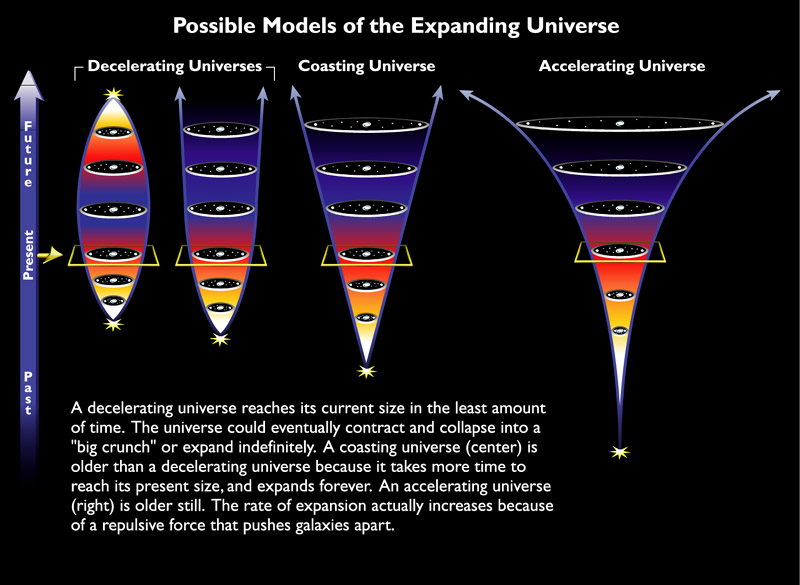Since we have been able to think we have wondered where did we come from, it’s a fundamental question that people have explored for thousands of years. However we have also had another question on our minds, how does the universe end and how do we go. Prophecies have been written throughout history by the Mayans, Vikings and probably most recently and frequently by Christians. Since the millennium we have lived through twenty doomsday predictions but the question still remains, how will all of this come to an end? Scientists and physicists have theorised many different scenarios, here are just a few:
1. The Big Rip
Edwin Hubble made the discovery that the universe is expanding, which answered many questions physicists had until the early 20th century. The discovery that the universe is expanding led to the realisation that it was once smaller and thus the Big Bang Theory was born. The Big Rip theory relies on the assumption that the universe will expand endlessly. It is theorised that this expansion will continue until the galaxies, stars and planets can no longer hold themselves together. Eventually it is suggested, all matter could be torn apart at an atomic or subatomic level. At a certain point, 16 billion years into the future (at the earliest) the universes density becomes less than critical density, at which point a gravitational singularity takes place. This would result in the universe starting to collapse back in on itself which could lead to another big bang.
2. The Big Freeze
The Big Freeze is also based on the expansion of the universe, however this time at increasing speeds. The heat within the universe will be dispersed throughout, as planets, stars and galaxies are pulled apart. Eventually the stars will die out as the raw materials to form them are too far dispersed from each other to form another. The universe eventually reaches a temperature of absolute zero and can no longer function. This point may come before absolute zero however this whole theory balances on unraveling the mystery of dark matter which makes up more than what we have already observed; everything we have observed up to this point currently only makes up 5%.
3. The Big Crunch
The big crunch is based on the idea that universal expansion does not continue forever but that, if the universe’s average density becomes thin enough to halt expansion, the universe could begin the process of collapsing in on itself; falling just short of “The Big Tear”. This could be a result of a collection of gravitational pulls that draws spacetime down into a single point, or a black hole like state. Another cause for the universe to collapse in on itself would be a reversal of dark energy and its current role on the expansion of the universe. However more studies are needed to fully understand dark energy, which is estimated to make up 73% of all mass and energy in our universe. While this theory shares similarities with the Big Tear they are in fact quite different. In the big tear scenario all matter is torn apart, whereas the Big Crunch begins to contract in a more controlled fashion. Galaxies, stars and planets remain intact at the moment of contraction.
4. The Big Bounce
While the big crunch reduces the universe to a black whole like singularity the big bounce would recycle the matter. A black hole is typically destroys all matter that it sucks in, but in this scenario the matter is not destroyed. It is theorised that the universe doesn’t reach a blackhole like singularity; before it would reach this state the matter bounces and is repelled. This results in the universe being reformed, or rather a new universe is produced. In this recycling process of the universe it is impossible to tell at what stage in the process we are currently in, this could be the first time of the cycle or the millionth time.
5. The Big Slurp
Finally there is The Big Slurp. This theory came about shortly after the discovery of the Higgs Boson, the particle that gives all matter mass, and it suggests that our universe could be inherently unstable. It is possible that our universe is currently working inside a metastable or temporarily stable state. Should this be the case, a “bubble” from another parallel universe could appear in ours at any time. Should this bubble have a lower energy density than that of our universes, a false or negative vacuum would occur and would engulf our universe at the speed of light. This would cause all protons to decay, resulting in all matter falling apart. This theoretically can happen at any time and any place in our universe.

The Big Rip, Big Crunch and Big Bounce theories all share a common theme, cycles. They all involve the universe returning to a single point where it can all begin again. It could be, as I mentioned before, we could be at any stage in this cycle, be it the first time or the millionth time. Although one hauntingly disturbing theory is that everything plays out the exact same every time. So all of this, you reading this article, that fight you got into or that puppy you saved occurs every time as the cyclical cosmological process continues.